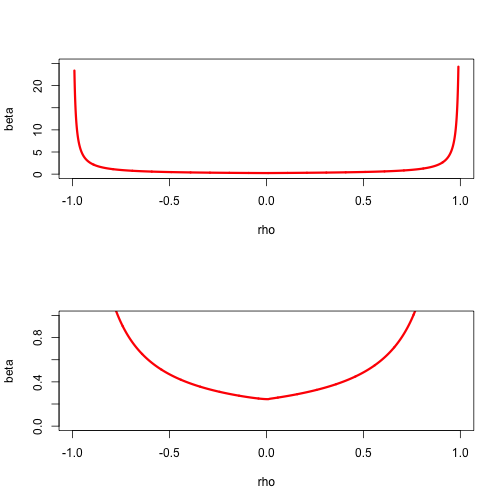II.5.5.2: Existence of Quadratic Majorizers
We first study the univariate case, following De Leeuw and Lange [2009]. If a quadratic majorizes a differentiable over at then we must have for all Define with, for continuity, Then we must have and consequently a quadratic majorizer exists if and only if
By the mean value theorem there is some between and such that Thus if is bounded on a quadratic majorizer exists. And if is unbounded on a quadratic majorizer does not exist.
From Taylor's theorem with integral form of the remainder which gives, by differentiating under the integral sign,
We now generalize some of these results to the multivariate case. If a quadratic majorizes a differentiable at then we must have for all This can be rewritten as the infinite system of linear inequalities in the elements of with If satisfies the inequalities , then clearly any also satifies them, and the set of all matrices satisfying is a closed convex set . Quadratic majorizers at exist if and only if is non-empty. Moreover if for all then for all Thus uniform boundedness of the second derivatives is sufficient for quadratic majorizers to exist. Note that if is concave then for all , and thus any , including , satisfies .
Although is convex and closed, it is generally not a simple object. We can give a simple necessary and sufficient condition for it to be non-empty. Choose an arbitrary positive definite . Define and Suppose . Take . Then for all we have and thus is a solution of . In fact, any is a solution. Conversely suppose and is a solution to , with largest eigenvalue . Then there is a such that , and thus , and , a contradiction. It follows that is necessary and sufficient for to be solvable and for to have a quadratic majorization at .
Nothing in this argument assumes that is positive semidefinite or that . In fact, for concave we have Also, of course, there is nothing that implies that the is actually attained at some . Note that the condition is independent of , although the value , if finite, depends on both and
We do know, from Taylor's Theorem (see section III.14.2.3), that if is twice continuously differentiable at then It follows that Also, because of the concavity of the minimum eigenvalue, and thus quadratic majorizations do not exist for any if is unbounded.
Example: As an example, consider defined by The function is convex, and as we have shown Let's look at the case in which has only two elements (as in simple logistic regression). We first study a simple subset of , those matrices which are positive definite and have equal diagonal elements. Thus with and Simply choose a and then numerically compute the corresponding This will give a convex region that is within

More generally we can parametrize by using with , , and The constraints on and define the interior of a circle in the plane with center and radius For each element in the circle we can compute the corresponding , which will give a complete description of